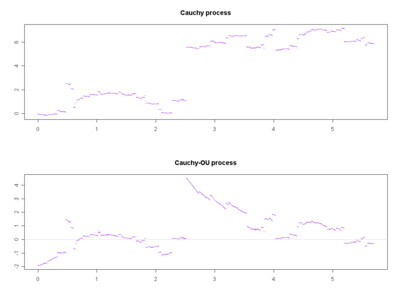Ornstein-Uhlenbeck trial
The Ornstein-Uhlenbeck process (often abbreviated OU process or OU for short ) is a special stochastic process named after the two Dutch physicists George Uhlenbeck (1900–1988) and Leonard Ornstein (1880–1941). In addition to the geometric Brownian motion, it is one of the simplest and at the same time most important processes defined by a stochastic differential equation . In Vasicek model for interest rate modeling Ornstein-Uhlenbeck processes are used.
Definition and parameters
Be and constants. A stochastic process is called Ornstein-Uhlenbeck process with initial value , equilibrium level , rigidity and diffusion , if it solves the following stochastic initial value problem:
- ,
where is a standard Wiener process .
The parameters are easy to interpret and can therefore be used as "adjusting screws" when modeling a stochastic time series :
- is the equilibrium level of the process (English: mean reversion level ). If it is above this value, the drift term is negative and the drift will tend to "pull" the process down. If it is smaller, the drift is positive and the process is pulled up in anticipation.
- (English mean reversion speed or mean reversion rate ) indicates how strong the "attraction" of is described above . For small values of disappearing this effect, for large values is very stiff to develop.
- indicates how strong the influence of (i.e. chance) is on the process. For will simply converge exponentially towards , with strong diffusion this convergence will be disturbed by chance.
The difference to the root diffusion process, which is also equipped with the mean reversion mechanism, or the geometric Brownian motion is essentially that in the OU process the diffusion term is constant, i.e. independent of . As a result, the OU process, in contrast to the other two, can also assume negative values.
Solution of the differential equation
In contrast to the root-diffusion process the above differential equation is solved explicitly, if not (as in the geometric Brownian motion) integrally free representable: With the solution of the corresponding homogeneous equation leads variation of parameters on the recognition , ie . If one applies the Itō's lemma on the one hand and the usual chain rule of differential calculus on the other hand , one obtains
- .
The above identity from 0 to integrated (where ) gives the solution
- .
properties
The Ornstein-Uhlenbeck process is a Gaussian process . This can be seen from the above solution: The integrand is deterministic, so the value of the Ito integral is always normally distributed .
Like every Gauss process, the Ornstein-Uhlenbeck process is uniquely determined by its expected value and covariance function in its distribution . These result as
- and
- .
In other words, it is normally distributed as follows:
- .
Since both the expected value and the variance for converge , there is a stationary distribution for the Markov process : It is a normal distribution with expected value and variance . In contrast to the Wiener process, the Ornstein-Uhlenbeck process is (weakly) stationary. One then says that the process has an “invariant measure ”: then applies to each
- .
So the process has no asymptote at .
The Ornstein-Uhlenbeck process is - like the root diffusion process - an affine process .
In some respects the Ornstein-Uhlenbeck Trial is more complicated than the Wiener Trial. For large time scales, however, it can be approximated using the Wiener process. It applies in terms of distribution convergence
Lévy trials
If the defining differential equation is driven by a different Lévy process than the Brownian motion, a (non-Gaussian) Ornstein-Uhlenbeck process is also obtained.
literature
- GE Uhlenbeck, LS Ornstein: On the theory of Brownian Motion. In: Physical Review. 36, 1930, pp. 823-841.
- DT Gillespie: Exact numerical simulation of the Ornstein-Uhlenbeck process and its integral. In: Physical Review E. 54, 1996, pp. 2084-2091.
Individual evidence
- ^ LCG Rogers and D. Williams: Diffusions, Markov Processes and Martingales . Vol. 1. Cambridge University Press, Cambridge, 2000, p. 54.

































